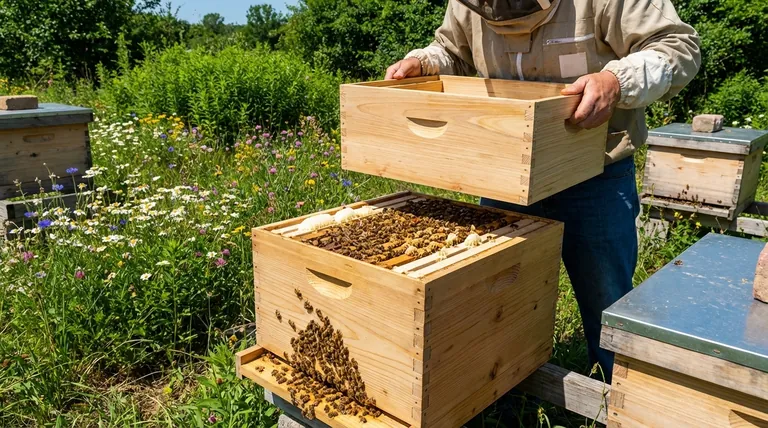The right time to add a honey super is just before the bees need it, typically when the top box of the hive is between 70% and 80% full of bees, brood, and resources. This ensures the colony has space to expand and store incoming nectar without becoming overcrowded, which can trigger a swarm.
The core principle is proactive space management. Your goal is not to react to a full hive, but to anticipate the colony's growth and provide expansion room just as they begin to feel crowded, aligning with the start of a local nectar flow.

Why Supering at the Right Time is Critical
Timing is a balancing act. Moving too early or too late carries significant consequences for the health of the colony and the success of your honey harvest.
The Danger of Adding Supers Too Late
When bees run out of space, they instinctively prepare to swarm. The queen's laying area becomes congested with nectar, a condition known as being honey-bound.
This lack of space for the queen to lay eggs is a primary trigger for the hive to raise a new queen and for the old queen to leave with half the workforce, drastically reducing your honey production.
The Problem with Adding Supers Too Early
Giving the colony too much space before they are ready can also cause problems. The bees may struggle to patrol the extra territory, making it vulnerable to pests like wax moths or small hive beetles.
Furthermore, a smaller colony will have difficulty maintaining the proper temperature and humidity in a cavernous space, especially during cool spring nights.
Key Signals Your Hive is Ready for a Super
Instead of relying on a calendar, learn to read the signs the bees are giving you.
The 70-80% Rule
This is the most reliable indicator. During an inspection, look at the top box. If the bees have drawn out the comb and are actively using seven or eight of the ten frames for brood, pollen, or nectar, it is time to add a super.
Observing the Nectar Flow
The "nectar flow" is when major nectar-producing plants in your area are in full bloom. You will see heavy bee traffic at the hive entrance, with many bees returning loaded with pollen. This is a clear signal that the hive needs storage space.
Whitening of the Comb
When bees are actively building and drawing out comb, they add fresh, white wax. If you see new, white wax being built up on the top bars of the frames, it's a tell-tale sign they are running out of room and are looking for new space to build.
The Role of the Queen Excluder
A queen excluder is a grate placed between the brood boxes and the honey supers. It allows worker bees to pass through but is too small for the larger queen, ensuring the honey supers remain free of eggs and brood.
When to Add the Excluder
If you choose to use one, place it on the hive at the same time as your first honey super. However, there is a critical temperature consideration.
Why Excluder Timing Matters
Do not add a queen excluder until nighttime temperatures are consistently above 50°F (10°C). Adding it too early in the spring can trap the queen in the lower brood box. If a late cold snap occurs, the worker bee cluster may move up into the warmer part of the hive, leaving the queen behind to chill and perish.
A Simple Checklist for Adding Supers
Use these guidelines to match your actions to your goals and hive conditions.
- If you are a new beekeeper: Rely on the 70-80% rule as your primary guide. It is the most direct and reliable signal the hive provides.
- If you live in a region with a strong, predictable nectar flow: You can add the first super just before you see the main bloom to get ahead of the influx.
- If you plan to use a queen excluder: Wait until you are confident that cold nights are over to ensure you do not risk the queen's safety.
Ultimately, consistent observation is the most valuable skill in beekeeping.
Summary Table:
| Key Signal | What to Look For | Action Required |
|---|---|---|
| 70-80% Rule | 7-8 out of 10 frames in the top box are full of brood, pollen, or nectar. | Add a super immediately. |
| Nectar Flow | Heavy bee traffic with pollen loads; major local plants in bloom. | Add a super proactively. |
| Comb Whitening | Fresh, white wax being built on top bars. | Colony needs more space; add a super. |
| Queen Excluder Use | Nighttime temps consistently above 50°F (10°C). | Place excluder with the first super. |
Optimize your apiary's productivity with HONESTBEE. As a trusted supplier for commercial apiaries and beekeeping equipment distributors, we provide high-quality honey supers, excluders, and other essential gear to support your timing and space management strategies. Ensure your hives are equipped for maximum yield—contact our expert team today to discuss your wholesale needs and enhance your beekeeping success.
Visual Guide

Related Products
- Langstroth Honey Bee Box Hive Boxes for Different Depths
- Professional 500g Sectional Comb Honey Frame System for Beekeeping
- Economy Small Scale Honey Dryer Dehumidifier Thickening Machine
- High-Efficiency Diamond Maze Bee Escape for Clearing Supers
- Commercial 48-Frame Stainless Steel Honey Extractor
People Also Ask
- What are the sizes available for Langstroth boxes? A Guide to 8-Frame vs. 10-Frame & Depths
- What is the best time to inspect a hive? Optimize for Bee and Beekeeper Safety
- How is checking honey supers in a Langstroth hive different from inspecting Honey Flow supers? A Guide to Disruptive vs. Non-Invasive Methods
- How deep is a medium bee box? Unlock the Key to a Versatile and Manageable Hive
- What is the purpose of the boxes in a Langstroth hive? A Guide to Modular Beekeeping Success



















